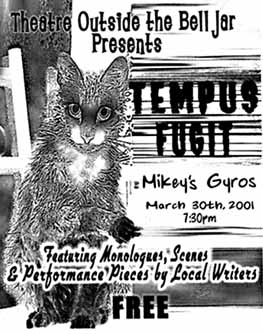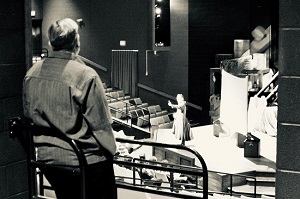
A Rumination from my dramaturgy of Steven Dietz’s This Random World directed by David Lee-Painter (DLP).
Three things at the heart of our production process: Mindfulness, World Building, Shadow Work
Mindfulness
In retrospect, I think I was the only one who said the word “mindfulness” aloud. But it was consciously attended to. Leading up to rehearsals, I had wondered, what would be the best way to discuss mindfulness with the company? And, how to present it in such a manner that it would be useful to their work? Several of the actors used meditation in their personal life so it was not an unfamiliar idea. Did we need to have a discussion on it? There was an instructor on campus who taught meditation. Perhaps she would come in for a session? Or we should integrate mediation into the rehearsal warm-ups?
DLP and I had talked about mindfulness and its place in the play. The first night with the company, he emphasized the need for “…an intimate, interdependent vitality …. Actors jump up and help their cast mates” (First Night Notes). There was an emphasis on the ensemble and an awareness of each other.
Being mindful not only assisted the process but fed the story that Dietz was telling. Beth and her brother Tim illustrated how little they knew about what was happening in each other’s lives. At one point, Beth challenged her brother: “…do you have any actual evidence that you are, in fact, living and breathing and connected in some way to the known world?!” Dietz also set the play in locations that press in on the characters: a funeral parlor, a hospital, a Shinto shrine, even a wilderness in Nepal. These are places that arguably are personalities themselves in the story that the characters cannot be unaware of.
Co-director, Daniel L. Haley led the company through team building exercises that developed not only trust but cognizance and group reliance. It is anticipated that a company develops some form of bond through the course of any project. For the script work that DLP had in mind for this production, a strong sense of collaboration would strengthen the overall process. Also, they needed a foundational cohesiveness from the beginning. The bulk of This Random World is two-person scenes. We would be several weeks into rehearsals before the entire company worked together again.
World Building
The Forge is the university’s black box theater, and for this production, it was configured in the round with four alley entrances. Entering the theater, the audience was greeted to Jared Sorenson’s beautifully understated set, ringed by river rock with a serene cloud floating above.
In This Random World’s script notes, Dietz writes: “A few simple and permanent units should suffice for everything. Transformations between them should be quick and easy.” We latched onto scene changes being “transformations” (another of many transformations within the play) and saw them as opportunities for storytelling. DLP chose to have worldbuilders who would move the audience from one mood and location to the next.
For our production, the entire company was an ensemble. Members without lines were worldbuilders. They also understudied a role with lines. The ensemble with speaking parts understudied a worldbuilder. During tech week an understudy performance was given.
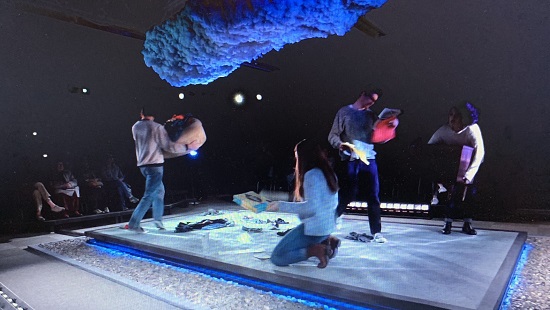
During the transformations, the worldbuilders not only complete a set change but interact with the scenic elements and properties as the people you would find in the spaces the story was shifting into. Coming out of the diner scene, the ensemble wore aprons as waitstaff and set the table and chairs. Moving from Tim’s apartment into a park, they were walkers, lovers, and even the characters Gary & Claire passed through. Into the airport, they were travelers making connections. Gary was there again to help Scottie with her walker off stage.

All the transformations were a flurry of choreographed movement. I felt the effect was akin to a wave hitting the stage and when it retreated only the performers for the scene remained. The largest transformation was from preshow into the show when the worldbuilders created Tim’s cluttered apartment in a matter of seconds.
Shadow Work
The most fascinating part of the production for me was the method DLP used in the early part of rehearsal as the actors were getting off book. I’d never seen it before. We referred to it as “shadow work.” The actors always had another person at their elbow with a script.
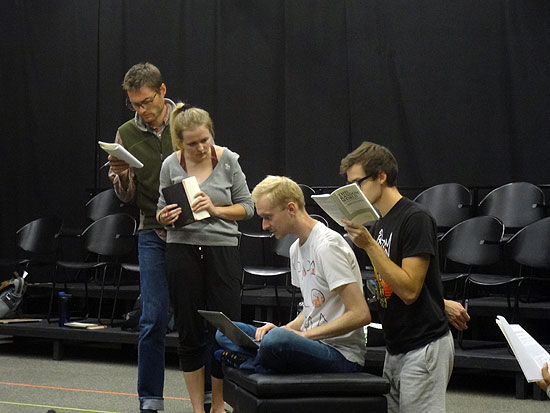
The script holder whispered the lines to the actor. When describing the method, DLP explained that shadow work required authentic listening and connection from the first rehearsal. Actors were not hampered by carrying a script which allowed blocking and more in-depth character work to start sooner (“First Rehearsal”).
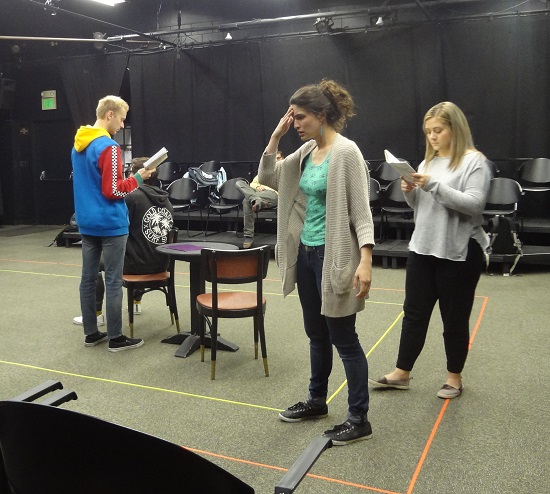
After a rehearsal period was concluded, the ensemble members traded places and the script holder became the actor. Initially, the performers expressed uneasiness with this new process and wondered if their beloved co-director had lost his mind but rapidly they became comfortable with it and found the technique lent itself to swifter line memorization.
With two actors sharing a role, they worked independently, together, and with the company telling the character’s story and the story of This Random World. This process increased the learning opportunities and the potential teachers in the rehearsal hall at any given moment. Peers exchanged knowledge, becoming both “lead” and “understudy.” It also offered a different way to experience both sides of the acting coin in one process and be fully engaged. It created a synergic dance that the stage management team was challenged to track and record as it changed from night to night.
During rehearsals, I was reading an article by Cope & Augustijnen which spoke of “’bardo’– the Buddhist idea of an in-between moment of heightened consciousness, a moment of choice and of transition between the past and the future, between confusion and wisdom.” This idea of confusion and wisdom resonated with me as the actors took on shadow work and brought it into their more familiar routines of preparation. It also layered into This Random World’s themes. The characters all seemed to be somewhere in that liminal space themselves.
It was exciting for me to be involved in this process and see how it echoed into the play itself with its themes on transformation, transition, and awareness.
Cope & Augustijnen, “Going ‘Au-delà’: A Journey into the Unknown,” from New Dramaturgy: International Perspectives on Theory and Practice, p. 168.
Dietz, Steven. This Random World.
Lee-Painter, David. “First Rehearsal Remarks.”
Lee-Painter, David. “Opening Night Remarks.”
